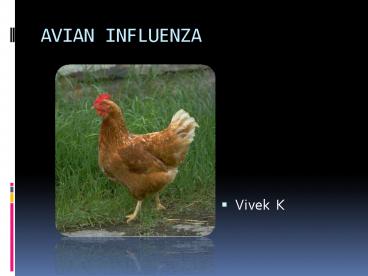AVIAN INFLUENZA - PowerPoint PPT Presentation
1 / 15
Title: AVIAN INFLUENZA
1
AVIAN INFLUENZA
- Vivek K
2
Introduction
- Avian influenza or Avian flu, or Bird flu refers
to "influenza caused by viruses adapted to birds.
- H5N1 strain can infect human
- First noted in 1997
3
Current status of Avian Influenza in Poultry
4
How Human to Human Transmission Occurs
5
Recent Human Infections by Avian flu
6
Why are we so concerned?
- Number of affected countries with avian influenza
increasing - Number of avian and human cases increasing
- The majority of the human population has no
immunity - High case fatality rate
- Human influenza viruses are circulating in Asian
countries - Potential of emergence of a new influenza virus
Increasing risk of human to human transmission
with pandemic potential
7
WHO Pandemic Phases
- Inter-pandemic Period
- Phase 1 no novel influenza virus subtypes
detected in humans - Phase 2 same, but circulating animal virus
posing significant risk to humans - Pandemic Alert Period
- Phase 3 human infection with a novel subtype but
no h-t-h transmission - Phase 4 small cluster with h-t-h transmission
- Phase 5 larger cluster with h-t-h transmission,
virus becoming increasingly adapted to humans
(substantial pandemic risk)
8
WHO Pandemic Phases (contd)
- Pandemic Period
- Phase 6 Increased and sustained transmission in
the general population - Post Pandemic Period
- Return to Inter-pandemic Period
9
Signs Symptoms
- Fever. Headache. Tiredness (can be
extreme).Dry cough. Sore throat. Nasal
congestion. Body aches.
10
Laboratory Diagnosis
- Identification of the agent
- Live birds tracheal swabs and cloacal swabs or
faeces - Dead birds organs and faeces
- Serology
- Clotted blood samples or
- serum
11
Tests available
- ELISA
- AGID (Agar Gel Immunodiffusion test)
- HI (Haemagglutination Inhibition test)
- IFT (Immunofluoresence test)
- RT-PCR (Reverse-transcriptase polymerase chain
reaction)
12
Prevention and Control
- 1. Cullers and transporters should be provided
with appropriate personal protective equipment - Protective clothing, with an impermeable apron or
surgical gowns - gloves must be disinfected.
- respirator masks are preferred. Standard
well-fitted surgical masks should be used if
respirators are not available. - Goggles.
- Rubber or polyurethane boots that can be
disinfected or protective foot covers that can be
discarded. 2. All persons who have been in
close contact with the infected animals should
wash their hands frequently with soap and water.
Cullers and transporters should disinfect their
hands after the operation. - 3. Environmental clean up should be carried out
in areas of culling.
13
Treatment
- Rest.
- Drink plenty of liquids. Avoid using alcohol
and tobacco. - Take medication to relieve the symptoms of
flu
14
Drugs
- Amantadine
- Zanamivir
- Oseltamivir
15
Thank You

